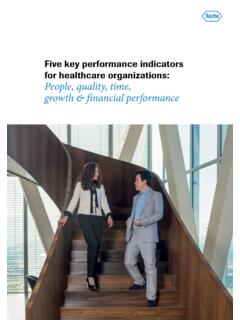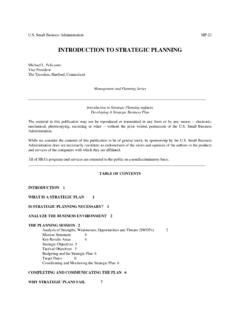Transcription of Key Risk Indicators - Institute of Operational Risk
1 Institute of Operational Risk Operational Risk Sound Practice Guidance Key Risk Indicators November 2010 Key Risk Indicators Institute of Operational Risk Sound Practice Guidance Copyright 2010 Institute of Operational Risk 2 The Institute of Operational Risk Sound Practice Guidance The Institute of Operational Risk (IOR) recognises that there is no one size fits all approach to the management of Operational risk. However by drawing on the experience of practising risk professionals it is possible to identify examples of good practice described in this paper. Equally it is hoped that these guidance papers will facilitate a shared understanding of key Operational risk concepts amongst risk management professionals, regulators and academics, thus contributing towards the further development of the discipline of Operational risk.
2 This is one of a series of Sound Practice Guidance papers being produced by the IOR with the following objectives: Providing information on the practicalities and know-how necessary in order to implement the techniques that support a robust Operational risk management framework; Empowering Operational risk professionals to demonstrate the value of Operational risk management to senior management in a practical rather than theoretical manner; Capturing the real experience of practising risk professionals, including the challenges involved in developing Operational risk management frameworks. This paper is available from the Institute s website at If you have comments or suggestions on this paper please contact us on The Institute of Operational Risk The Institute of Operational Risk was created in January 2004 as a professional body whose aim is to establish and maintain standards of professional competency in the discipline of Operational Risk Management.
3 It is an independent, not for profit, professional body designed to support its members. The stated mission of the Institute is to promote the development and discipline of Operational Risk and to foster and maintain investigations and research into the best means and methods of developing and applying the discipline and to encourage, increase, disseminate and promote knowledge, education and training and the exchange of information and ideas. Key Risk Indicators Institute of Operational Risk Sound Practice Guidance Copyright 2010 Institute of Operational Risk 3 1. Introduction .. 1 2. 1 Risk Indicators .. 1 Control Effectiveness Indicators .. 2 performance Indicators .
4 2 Indicators generically .. 2 Key Indicators .. 2 3. Role and Purpose: Using Risk 3 Indicators and Risk Monitoring .. 3 Using Indicators to Support Operational Risk Assessments .. 3 Indicators , Risk Appetite and 4 performance Management and Strategic Management .. 4 Regulation and Capital Assessments .. 4 4. Selecting Risk Indicators .. 5 The Desirable Characteristics of Risk Indicators .. 5 Relevance .. 5 Measurable .. 6 Predictive .. 6 Easy to Monitor .. 7 Auditable .. 8 Comparability .. 8 The Selection Process Top-Down versus Bottom-Up .. 8 How Many Indicators are Enough? .. 9 Composite or Index Indicators .. 9 5. Thresholds, Limits and Escalation 10 Thresholds and Limits.
5 10 Specialised Thresholds .. 11 Escalation Triggers .. 12 6. Managing Risk Indicators .. 12 Starting Off .. 12 Adding or Changing Indicators .. 12 indicator Dimensions and Buckets .. 13 Changing Thresholds and Limits .. 14 Data Collection and Management .. 14 Taking Action to Resolve Unacceptable Indicators .. 14 7. 14 To Whom? Levels of Reporting .. 14 Key Risk Indicators Institute of Operational Risk Sound Practice Guidance Copyright 2010 Institute of Operational Risk 4 Frequency of Reporting .. 16 Presenting Risk Indicators .. 16 Prioritising Risk Indicators .. 17 Size .. 17 Trends .. 18 Dependencies between Indicators .. 18 8. Appendices.
6 20 Common Categories of Risk indicator for All Major Industry Sectors .. 20 Specific Sample Indicators for Financial Institutions .. 22 Agency Services .. 22 Asset Management .. 23 Commercial Banking .. 24 Corporate Finance .. 24 Payments and Settlements .. 25 Retail Banking .. 25 Retail Brokerage .. 26 Trading and Sales .. 27 Corporate Services .. 28 Insurance .. 29 Example Documentation .. 30 Example Report for Management .. 33 Example Report for Board .. 35 Composite Indicators .. 36 Web Resources .. 37 Title: Key Risk Indicators Date issued: 2nd Nov 2010 Version: 1 File name: IOR KRI Guidance Nov 2010 Update date: n/a Key Risk Indicators Institute of Operational Risk Sound Practice Guidance Copyright 2010 Institute of Operational Risk 1 1.
7 Introduction Risk Indicators are an important tool within Operational risk management, facilitating the monitoring and control of risk. In so doing they may be used to support a range of Operational risk management activities and processes, including: risk identification; risk and control assessments; and the implementation of effective risk appetite, risk management and governance frameworks (see IOR Guidance on Risk Appetite and Risk Governance). Despite their usefulness relatively little guidance exists on how to use risk Indicators in an effective manner. Moreover it is an area that has proven to be particularly challenging for many organisations.
8 Hence there is a need for further guidance in this area. What follows is the IOR s perspective on current sound practices in relation to the use of risk Indicators to support the management of Operational risk. In so doing, this guidance covers the role and purpose of risk Indicators , the elements of an effective risk indicator framework and some important practical considerations relating to the use of such frameworks within an Operational risk management context. 2. Definitions Indicators are metrics used to monitor identified risk exposures over time. Therefore any piece of data that can perform this function may be considered a risk indicator .
9 The indicator becomes key when it tracks an especially important risk exposure (a key risk), or it does so especially well (a key indicator ), or ideally both. More specifically a metric may be considered to be a risk indicator when it can be used to measure: The quantum (amount) of exposure to a given risk or set of risks. The effectiveness of any controls that have been implemented to reduce or mitigate a given risk exposure. How well we are managing our risk exposures (the performance of our risk management framework). Expressed slightly differently, this implies that an organisation will typically make use of three different types of indicator : risk (exposure) Indicators , control effectiveness Indicators and performance Indicators .
10 Risk Indicators In an Operational risk context a risk indicator (commonly known as a key risk indicator or KRI) is a metric that provides information on the level of exposure to a given Operational risk which the organisation has at a particular point in time. In order to provide such information the risk indicator has to have an explicit relationship to the specific risk whose exposure it represents. For example, take the number of customer complaints, which is likely to be linked to the risk of process errors as customer complaints increase, the probability that there are some underlying and potentially systemic mistakes and errors of judgement being made is likely to rise.






